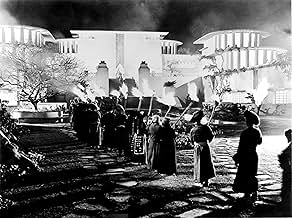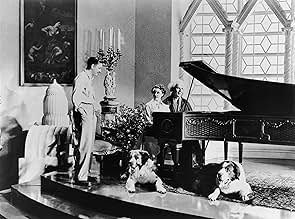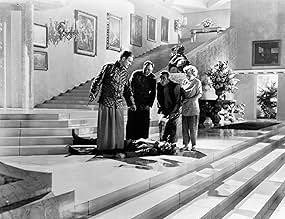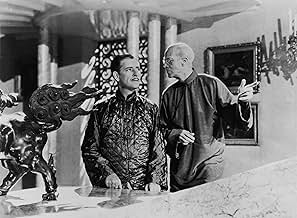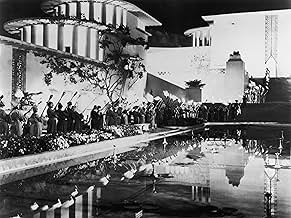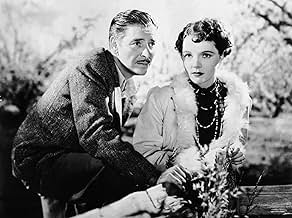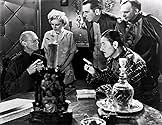CALIFICACIÓN DE IMDb
7.6/10
15 k
TU CALIFICACIÓN
Cuando el avión de un reverenciado diplomático se desvía y se estrella en los picos del Tíbet, él y los otros sobrevivientes son guiados a un monasterio aislado en Shangri-La, donde luchan c... Leer todoCuando el avión de un reverenciado diplomático se desvía y se estrella en los picos del Tíbet, él y los otros sobrevivientes son guiados a un monasterio aislado en Shangri-La, donde luchan con la invitación de quedarse.Cuando el avión de un reverenciado diplomático se desvía y se estrella en los picos del Tíbet, él y los otros sobrevivientes son guiados a un monasterio aislado en Shangri-La, donde luchan con la invitación de quedarse.
- Dirección
- Guionistas
- Elenco
- Ganó 2 premios Óscar
- 6 premios ganados y 6 nominaciones en total
Norman Ainsley
- Embassy Club Steward
- (sin créditos)
Chief John Big Tree
- Porter
- (sin créditos)
Wyrley Birch
- Missionary
- (sin créditos)
Beatrice Blinn
- Passenger
- (sin créditos)
Hugh Buckler
- Lord Gainsford
- (sin créditos)
Sonny Bupp
- Boy Being Carried to Plane
- (sin confirmar)
- (sin créditos)
John Burton
- Wynant
- (sin créditos)
Tom Campbell
- Porter
- (sin créditos)
Matthew Carlton
- Pottery Maker
- (sin créditos)
- Dirección
- Guionistas
- Todo el elenco y el equipo
- Producción, taquilla y más en IMDbPro
Opiniones destacadas
Frank Capra classic about a group of British citizens, led by diplomat Robert Conway (Ronald Colman), who flee a rebellion in China only to have their plane crash in the Himalayas. They are taken to Shangri-La, a magical place isolated in the mountains where people can leave behind the worries of civilization. They learn they will live for hundreds of years there but only if they never leave. The world-weary Conway is intrigued by the promise of this utopia but not everyone in his group feels the same way.
It's an ambitious undertaking for Capra, who made no other movies on the scale of this one (or with the budget). The costumes and Art Deco sets are beautiful. Great script from Robert Riskin, adapted from James Hilton's novel. Lovely, haunting score from Dimitri Tiomkin. Ronald Colman, an exceptional actor who never did a bad job that I've seen, gives a moving, sincere performance that ranks among the best of his impressive career. Sam Jaffe is also excellent in his small but important role as the High Lama. The rest of the wonderful cast includes John Howard, Jane Wyatt, Edward Everett Horton, H.B. Warner, Isabel Jewell, and Thomas Mitchell (the first of four movies he did with Capra). Jane Wyatt's swimming scene is probably the sexiest thing she ever did on film. The opening scenes are exciting and the climax is powerful. The middle of the film is where many people complain that it's slow or that it loses focus. I admit there is a chunk of the middle of the film, dealing with Colman and Wyatt falling in love, as well as everyone adjusting (or not adjusting) to Shangri-La that drags just a bit. But I never felt bored and I don't think it derails the film at all. The dialogue and performances in these scenes is still great. The original cut ran much longer and I can only imagine whether that version would be better or worse. As it is, seven minutes of footage is still missing from the current version. The dialogue for these scenes is intact, with production stills in place of the missing footage.
It's escapism, pure and simple. Many viewers will poke holes in the idea and philosophy behind Shangri-La, calling it naive and childish. Perhaps they're right; perhaps the cold, cynical reality of selfish human nature means such a utopia is impossible. But the thing about most of Frank Capra's films, and why he is probably my favorite director ever, was that he believed in telling uplifting, optimistic stories about us helping each other overcome our baser nature; that good can triumph over evil and there are such things as happy endings. While Lost Horizon is not really one of his "Capra-corn" movies, I think the basic Capra elements are still there, right down to the final shot. Most other directors would have likely gone for the sad or tragic ending, but Capra gives us one that is hopeful.
It's an ambitious undertaking for Capra, who made no other movies on the scale of this one (or with the budget). The costumes and Art Deco sets are beautiful. Great script from Robert Riskin, adapted from James Hilton's novel. Lovely, haunting score from Dimitri Tiomkin. Ronald Colman, an exceptional actor who never did a bad job that I've seen, gives a moving, sincere performance that ranks among the best of his impressive career. Sam Jaffe is also excellent in his small but important role as the High Lama. The rest of the wonderful cast includes John Howard, Jane Wyatt, Edward Everett Horton, H.B. Warner, Isabel Jewell, and Thomas Mitchell (the first of four movies he did with Capra). Jane Wyatt's swimming scene is probably the sexiest thing she ever did on film. The opening scenes are exciting and the climax is powerful. The middle of the film is where many people complain that it's slow or that it loses focus. I admit there is a chunk of the middle of the film, dealing with Colman and Wyatt falling in love, as well as everyone adjusting (or not adjusting) to Shangri-La that drags just a bit. But I never felt bored and I don't think it derails the film at all. The dialogue and performances in these scenes is still great. The original cut ran much longer and I can only imagine whether that version would be better or worse. As it is, seven minutes of footage is still missing from the current version. The dialogue for these scenes is intact, with production stills in place of the missing footage.
It's escapism, pure and simple. Many viewers will poke holes in the idea and philosophy behind Shangri-La, calling it naive and childish. Perhaps they're right; perhaps the cold, cynical reality of selfish human nature means such a utopia is impossible. But the thing about most of Frank Capra's films, and why he is probably my favorite director ever, was that he believed in telling uplifting, optimistic stories about us helping each other overcome our baser nature; that good can triumph over evil and there are such things as happy endings. While Lost Horizon is not really one of his "Capra-corn" movies, I think the basic Capra elements are still there, right down to the final shot. Most other directors would have likely gone for the sad or tragic ending, but Capra gives us one that is hopeful.
Along with A TALE OF TWO CITIES, THE PRISONER OF ZENDA, and THE LIGHT THAT FAILED, LOST HORIZON represented the best performance possible out of Ronald Colman. And his Robert Conway is the most modern of them (up to the time the films were made). LOST HORIZON is set (as James Hilton intended) in the 1930s, in war torn China. It is not the only reference in the story to the 1930s that Hilton puts into his fable of a paradise on earth.
Hilton had reason to fear about the world he lived in. The Great War (as the First World War was generally called in the 1930s) was still a savage and recent nightmare. The 1920s and 1930s saw dictatorships seize control of European and Asian state, and Democracy retreating everywhere. "Look at the world", says the High Lama (Sam Jaffe), "Is anything worse?" The High Lama is correct - the world is collapsing, and the so-called panaceas (Communist Russia, Nazi Germany, Fascist Italy and Spain, Imperial Japan and it's "Greater Asiatic Co-Prosperity Sphere") are worse than the seeming ineptitude and drift in badly divided France, weakened Britain, and recovering American.
Hilton took Conway, his brother George, Professor Edward Everett Horton, suspiciously quiet businessman Thomas Mitchell, and consumptive Isabel Elsom to an oasis (possibly the oasis) on that troubled old earth - Shangri La, or "the valley of the Blue Moon") where contentment and peace reigned and people could live, if not forever, far longer and more happily than in say 1937 Germany, Britain, France, Russia, Italy, the U.S., or Japan.
On the whole Capra catches the spirit of the novel - his sets were dismissed as being far to simplistic, but as simplicity is the hallmark of life at Shangri-La the critics seemed to miss the point. As a matter of fact, his sets (in a temperate valley in the Himalayas - a real impossibility) are more acceptable than the idiocies of the future world in the contemporary science fiction film THINGS TO COME, where H.G.Wells believes we should live in cities built in caves.
The acting is very good, particularly Sam Jaffe's ancient High Lama (always shot in shadows). Remember, he is over two hundred years old. Today, because Jaffe had a long career in Hollywood (despite being blacklisted in the 1950s), we think of him as an old man in THE ASPHALT JUNGLE or as "Dr. Zorba" in the series BEN CASEY. So we think he must have looked old in real life when LOST HORIZON was shot. Actually, he was in his thirties or forties, so he was not that old. But he gave a performance that suggested he was an old man.
Another member of the cast that I would wish to bring up for consideration is John Howard. He is not recalled by film fans too much, but Mr. Howard was a good, competent actor. That he played Hugh "Bulldog" Drummond in a series of "B" features in the late thirties makes it ironic that he played the younger brother of Ronald Colman here, who had begun the talking picture segment of his career with the same role. Howard does not have a British accent, but he does show the adoration of the younger brother for his famous sibling, and the growing anger and contempt he develops when brother Robert fails to plan for their leaving this prison they were dragged to - note how he wants to return with a bomber to destroy Shangri-La. It is one of the two roles in major films that John Howard is remembered for, the other being "George Kittridge", the erstwhile fiancé of Tracy Lord (Katherine Hepburn) in THE PHILADELPHIA STORY, who is pushed aside by both Cary Grant and James Stewart.
As it is one of Howard's best roles, it is nice that when the film was restored (as well as possible) in the 1980s, Howard (one of the three surviving cast members) was able to appreciate it - many of the missing sequences were his scenes. Howard was very happy at the restoration result.
Now, one or two notes that may help appreciate the film a little more. Who is Robert Conway supposed to be? He is called, by the High Lama, "Conway, the empire builder." He is supposedly able to do impossible things - hence the admiration of his brother. When he returns to Shangri-La at the end, the comment of the man telling the story is that Conway's journeys by himself back to his valley was beyond what ordinary men could do. So who is Conway? Well, in 1937, the model for Robert Conway was dead, from a motorcycle accident, for two years. It was, of course, Thomas Edward Lawrence "of Arabia", who had never been in Tibet (officially, anyway) but had served time in the Indian subcontinent area on government business in the 1920s. Quite a model for an empire builder.
The character played by Thomas Mitchell is also based on a real person. Harry Barnard's real name (which I have forgotten) is that of an international financier whose vast empire collapsed ruining thousands of investors. It turns out Mitchell's character is based on Samuel Insull, a mid western utilities empire builder (out of Chicago) whose financial doings brought about his collapse in the Great Depression. Insull fled in disguise to Greece, but was found on a dirty freighter, and returned to the U.S. (where he would stand trial for fraud, but be acquitted). Edward Everett Horton's anger at Mitchell when he learned the latter's identity is understandable. Mitchell's involvement in installing new pipes in Shangri-La mirrors Insull's early days, when he was an electrician, and an assistant to Thomas Edison.
The use of these two real figures as the basis of the characters helped contemporary audiences to accept the background of the plot of the film.
Hilton had reason to fear about the world he lived in. The Great War (as the First World War was generally called in the 1930s) was still a savage and recent nightmare. The 1920s and 1930s saw dictatorships seize control of European and Asian state, and Democracy retreating everywhere. "Look at the world", says the High Lama (Sam Jaffe), "Is anything worse?" The High Lama is correct - the world is collapsing, and the so-called panaceas (Communist Russia, Nazi Germany, Fascist Italy and Spain, Imperial Japan and it's "Greater Asiatic Co-Prosperity Sphere") are worse than the seeming ineptitude and drift in badly divided France, weakened Britain, and recovering American.
Hilton took Conway, his brother George, Professor Edward Everett Horton, suspiciously quiet businessman Thomas Mitchell, and consumptive Isabel Elsom to an oasis (possibly the oasis) on that troubled old earth - Shangri La, or "the valley of the Blue Moon") where contentment and peace reigned and people could live, if not forever, far longer and more happily than in say 1937 Germany, Britain, France, Russia, Italy, the U.S., or Japan.
On the whole Capra catches the spirit of the novel - his sets were dismissed as being far to simplistic, but as simplicity is the hallmark of life at Shangri-La the critics seemed to miss the point. As a matter of fact, his sets (in a temperate valley in the Himalayas - a real impossibility) are more acceptable than the idiocies of the future world in the contemporary science fiction film THINGS TO COME, where H.G.Wells believes we should live in cities built in caves.
The acting is very good, particularly Sam Jaffe's ancient High Lama (always shot in shadows). Remember, he is over two hundred years old. Today, because Jaffe had a long career in Hollywood (despite being blacklisted in the 1950s), we think of him as an old man in THE ASPHALT JUNGLE or as "Dr. Zorba" in the series BEN CASEY. So we think he must have looked old in real life when LOST HORIZON was shot. Actually, he was in his thirties or forties, so he was not that old. But he gave a performance that suggested he was an old man.
Another member of the cast that I would wish to bring up for consideration is John Howard. He is not recalled by film fans too much, but Mr. Howard was a good, competent actor. That he played Hugh "Bulldog" Drummond in a series of "B" features in the late thirties makes it ironic that he played the younger brother of Ronald Colman here, who had begun the talking picture segment of his career with the same role. Howard does not have a British accent, but he does show the adoration of the younger brother for his famous sibling, and the growing anger and contempt he develops when brother Robert fails to plan for their leaving this prison they were dragged to - note how he wants to return with a bomber to destroy Shangri-La. It is one of the two roles in major films that John Howard is remembered for, the other being "George Kittridge", the erstwhile fiancé of Tracy Lord (Katherine Hepburn) in THE PHILADELPHIA STORY, who is pushed aside by both Cary Grant and James Stewart.
As it is one of Howard's best roles, it is nice that when the film was restored (as well as possible) in the 1980s, Howard (one of the three surviving cast members) was able to appreciate it - many of the missing sequences were his scenes. Howard was very happy at the restoration result.
Now, one or two notes that may help appreciate the film a little more. Who is Robert Conway supposed to be? He is called, by the High Lama, "Conway, the empire builder." He is supposedly able to do impossible things - hence the admiration of his brother. When he returns to Shangri-La at the end, the comment of the man telling the story is that Conway's journeys by himself back to his valley was beyond what ordinary men could do. So who is Conway? Well, in 1937, the model for Robert Conway was dead, from a motorcycle accident, for two years. It was, of course, Thomas Edward Lawrence "of Arabia", who had never been in Tibet (officially, anyway) but had served time in the Indian subcontinent area on government business in the 1920s. Quite a model for an empire builder.
The character played by Thomas Mitchell is also based on a real person. Harry Barnard's real name (which I have forgotten) is that of an international financier whose vast empire collapsed ruining thousands of investors. It turns out Mitchell's character is based on Samuel Insull, a mid western utilities empire builder (out of Chicago) whose financial doings brought about his collapse in the Great Depression. Insull fled in disguise to Greece, but was found on a dirty freighter, and returned to the U.S. (where he would stand trial for fraud, but be acquitted). Edward Everett Horton's anger at Mitchell when he learned the latter's identity is understandable. Mitchell's involvement in installing new pipes in Shangri-La mirrors Insull's early days, when he was an electrician, and an assistant to Thomas Edison.
The use of these two real figures as the basis of the characters helped contemporary audiences to accept the background of the plot of the film.
Fantasy filled film that shows the different facaets of human nature. Beautifully conceived by Frank Capra whose brilliant at making films with sentlemenity as main force. A masterpiece which was brutally cut during its threaitcal run and only recently has the film been somewhat restored. Thus, the complete version of Lost Horizon(1937) is one of many lost classics in history of film. Acting is excellent with everyone giving deep performances. An wonderful story with intriquing spirital symbolisms. Ronald Colman does a marvalous job as the good natured and tolerate Robert Conway. Personally I perfer Lost Horizons(1937) over Its a Wonderful Life(1946) because the main character in the former is more complex.
I watched this film for the first time as a 10 year old and its effects on my willingness to be a optimistic idealist have always been led by my memories of this hope inspiring tribute to the need for the human being to find Heaven in this life. Perhaps Lost Horizon could have been that spark that enabled me to find just that. Like all films from another era do not judge this film for its apparent imperfections, rather for what it offered the audiences of that time (1937), hope that all would be well when man would recognize that his time is always better spent broadening his horizons of understanding. Frank Capra's guides his audiences through danger and turmoil to that place which dreams are made of, when we all make the effort to make it happen.
As of this writing "The Lost Horizon" is about to be released on blu-ray in its all new 4k restoration. The film (as well the remake) had major cuts made prior to there general release! Eventually both have footage lost or destroyed so a full directors cut of either film will never happen. Both film were box office failures on their initial releases. (The Remake is also not as bad as some people think)
In 1942, the film was re-released as The Lost Horizon of Shangri-La. A lengthy drunken speech delivered by Robert Conway, in which he cynically mocks war and diplomacy, had already been deleted in the general release version. Capra felt the film made no sense without the scene, and in later years film critic Leslie Halliwell described the missing 12 minutes as "vital". They were restored years later.
In 1952, a 92-minute version of the film was released. It aimed to downplay features of the utopia that suggested Communist ideals, a sensitive point after a Civil War in China resulted in the ascension of Mao Zedong's Communist Party in that country in 1949.
In 1973, the AFI initiated a restoration of the film. The project was undertaken by the UCLA Film and Television Archive and Columbia Pictures and took 13 years to complete. Although all 132 minutes of the original soundtrack were recovered, only 125 minutes of film could be found, so the seven minutes of missing film footage were replaced with a combination of publicity photos of the actors in costume taken during filming and still frames depicting the missing scenes.
This was also a device that Robert Harver did for his restoration of "A STAR IS BORN". That film had 30 minutes edited. Almost 30 years later he found most of the lost footage but when he did not have footage for the deleted scenes he also used stills.
In 2013, digital restoration of the film was done by Sony Colorworks. It was frame-by-frame restored at Prasad Corporation to remove dirt, tears, scratches and other artifacts.
This restoration I hope is better than the last one. Because of the deleted footage that was re-inserted back into the film was from different sources. The picture quality changes through out the film and that is distracting. The still sequences come off better!
For the film itself it is a joy to watch. It is a marvel. You so desperately want "Shangri-La" to exist. The story is a tad slow here and there but it is still a classic film that in general will hold your attention.
The film (When it was made) was a modern day look at the world we were living in! It is 1935. Before returning to England to become the new Foreign Secretary, writer, soldier, and diplomat Robert Conway (Ronald Colman) has one last task in China: to rescue 90 white Westerners in the city of Baskul. He flies out with the last few evacuees, just ahead of armed revolutionaries.
Unbeknownst to the passengers, the pilot has been replaced and their aircraft hijacked. It eventually runs out of fuel and crashes deep in the Himalayan Mountains, killing their abductor. The group is rescued by Chang (H.B. Warner) and his men and taken to Shangri-La, an idyllic valley sheltered from the bitter cold. The contented inhabitants are led by the mysterious High Lama (Sam Jaffe).
Initially anxious to return to civilization, most of the newcomers grow to love Shangri-La, including paleontologist Alexander Lovett (Edward Everett Horton), swindler Henry Barnard (Thomas Mitchell), and bitter, terminally-ill Gloria Stone (Isabel Jewell), who miraculously seems to be recovering. Conway is particularly enchanted, especially when he meets Sondra (Jane Wyatt), who has grown up in Shangri-La. However, Conway's younger brother George (John Howard), and Maria (Margo), another beautiful young woman they find there, are determined to leave.
Frank Capra's production design seems to have influenced "The Wizard of Oz" which was made 2 years later. There is certain sequences that "oz" echos.
In 1942, the film was re-released as The Lost Horizon of Shangri-La. A lengthy drunken speech delivered by Robert Conway, in which he cynically mocks war and diplomacy, had already been deleted in the general release version. Capra felt the film made no sense without the scene, and in later years film critic Leslie Halliwell described the missing 12 minutes as "vital". They were restored years later.
In 1952, a 92-minute version of the film was released. It aimed to downplay features of the utopia that suggested Communist ideals, a sensitive point after a Civil War in China resulted in the ascension of Mao Zedong's Communist Party in that country in 1949.
In 1973, the AFI initiated a restoration of the film. The project was undertaken by the UCLA Film and Television Archive and Columbia Pictures and took 13 years to complete. Although all 132 minutes of the original soundtrack were recovered, only 125 minutes of film could be found, so the seven minutes of missing film footage were replaced with a combination of publicity photos of the actors in costume taken during filming and still frames depicting the missing scenes.
This was also a device that Robert Harver did for his restoration of "A STAR IS BORN". That film had 30 minutes edited. Almost 30 years later he found most of the lost footage but when he did not have footage for the deleted scenes he also used stills.
In 2013, digital restoration of the film was done by Sony Colorworks. It was frame-by-frame restored at Prasad Corporation to remove dirt, tears, scratches and other artifacts.
This restoration I hope is better than the last one. Because of the deleted footage that was re-inserted back into the film was from different sources. The picture quality changes through out the film and that is distracting. The still sequences come off better!
For the film itself it is a joy to watch. It is a marvel. You so desperately want "Shangri-La" to exist. The story is a tad slow here and there but it is still a classic film that in general will hold your attention.
The film (When it was made) was a modern day look at the world we were living in! It is 1935. Before returning to England to become the new Foreign Secretary, writer, soldier, and diplomat Robert Conway (Ronald Colman) has one last task in China: to rescue 90 white Westerners in the city of Baskul. He flies out with the last few evacuees, just ahead of armed revolutionaries.
Unbeknownst to the passengers, the pilot has been replaced and their aircraft hijacked. It eventually runs out of fuel and crashes deep in the Himalayan Mountains, killing their abductor. The group is rescued by Chang (H.B. Warner) and his men and taken to Shangri-La, an idyllic valley sheltered from the bitter cold. The contented inhabitants are led by the mysterious High Lama (Sam Jaffe).
Initially anxious to return to civilization, most of the newcomers grow to love Shangri-La, including paleontologist Alexander Lovett (Edward Everett Horton), swindler Henry Barnard (Thomas Mitchell), and bitter, terminally-ill Gloria Stone (Isabel Jewell), who miraculously seems to be recovering. Conway is particularly enchanted, especially when he meets Sondra (Jane Wyatt), who has grown up in Shangri-La. However, Conway's younger brother George (John Howard), and Maria (Margo), another beautiful young woman they find there, are determined to leave.
Frank Capra's production design seems to have influenced "The Wizard of Oz" which was made 2 years later. There is certain sequences that "oz" echos.
¿Sabías que…?
- TriviaThe year after this film was released the owner of a prosperous theater chain hired an architect who designed a mansion that was inspired by the Shangri-La lamasery in this film. Located in Denver, Colorado, it still exists today.
- ErroresEchoing the words of the critic, James Agate: 'The best film I've seen for ages, but will somebody please tell me how they got the grand piano along a footpath on which only one person can walk at a time with rope and pickaxe and with a sheer drop of three thousand feet or so?'
- Créditos curiososBob Gitt of the UCLA Film & Television Archives claims the original opening sequence in 1937 had title cards "Conway has been sent to evacuate ninety white people before they're butchered in a local revolution" was changed in 1942 for a special reissue during WWII. The title cards read "before innocent Chinese people were butchered by Japanese hordes." This was to bolster propaganda against the Japanese.
- Versiones alternativasSome of the music in the restored version is dubbed into different sections than the ones in the 118 minute cut version. For example, the moment in which Robert Conway ('Ronald Colman') discovers that the High Lama is really Father Perrault i accompanied by soft music in the cut version, while in the restored version this moment is played with no music.
- ConexionesEdited from Stürme über dem Mont Blanc (1930)
- Bandas sonorasWiegenlied (Lullaby) Op. 49 No. 4
(1868) (uncredited)
Composed by Johannes Brahms
English translator unknown
Sung a cappella by children at Shangri-La
Selecciones populares
Inicia sesión para calificar y agrega a la lista de videos para obtener recomendaciones personalizadas
- How long is Lost Horizon?Con tecnología de Alexa
- Why was Maria so anxious to leave Shangri La?
- Why is Maria so anxious to leave Shangri La?
- Is the version usually seen faithful to the director's intentions?
Detalles
Taquilla
- Presupuesto
- USD 4,000,000 (estimado)
- Tiempo de ejecución2 horas 12 minutos
- Color
- Relación de aspecto
- 1.37 : 1
Contribuir a esta página
Sugiere una edición o agrega el contenido que falta

Principales brechas de datos
What is the German language plot outline for Horizontes perdidos (1937)?
Responda

